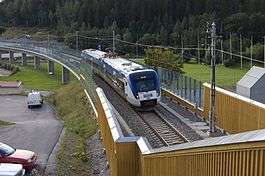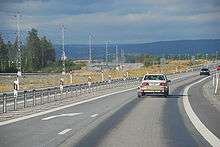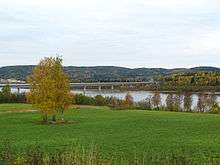Bothnia Line
The Bothnia Line (Swedish: Botniabanan) is a higher-speed railway line in northern Sweden. The 190 km (120 mi) long route, from Höga Kusten Airport, where it connects to Ådalen Line, via Örnsköldsvik to Umeå, was opened in 2010 and trains are allowed to travel at speeds up to 250 km/h (160 mph) (although no train with a higher top speed than 200 km/h (120 mph) uses the railway as of 2013).
| Bothnia Line | |
|---|---|
 Bridge through Örnsköldsvik | |
| Overview | |
| Type | High-speed railway |
| System | Swedish railway |
| Status | Open |
| Locale | Sweden |
| Termini | Höga Kusten Airport (connects Ådalen Line) Umeå |
| Operation | |
| Opened | 29 August 2010 |
| Owner | Botniabanan AB |
| Operator(s) | Swedish Transport Administration |
| Character | Passenger and freight |
| Technical | |
| Line length | 190 km (120 mi) |
| Number of tracks | 1 |
| Track gauge | 1,435 mm (4 ft 8 1⁄2 in) |
| Electrification | 15 kV 16.7 Hz AC |
| Operating speed | 200 km/h (120 mph) (design speed: 250 km/h (160 mph)) |
| Signalling | ERTMS |
Introduction
Completed in August 2010,[1] the Bothnia Line adds 190 kilometres (120 mi) of high-speed railway to the Swedish railway network. At up to 250 km/h (160 mph) this is also the highest-speed track in the country. The route branches off from the Ådalen Line at Höga Kusten Airport just north of Kramfors and goes via Örnsköldsvik to Umeå where it connects to the Umeå-Vännäs line and the Main Line Through Upper Norrland. The railway line has 140 bridges and 25 km of tunnels.
Construction was carried out by Botniabanan AB, a company owned 91% by the Swedish government and 9% by the municipalities of Kramfors, Örnsköldsvik, Nordmaling and Umeå. Work began on the line in 1999, and reached the halfway point at the end of 2005. After its completion in 2010, the line was leased to the Swedish Rail Administration. When Botniabanan AB has recovered its investment (estimated to be 2050), the ownership of the line will pass to the Rail Administration. The construction budget was SEK 15 billion.
It is intended that the Bothnia Line will compete with road transport using the European route E4, which is a main road carrying heavy freight traffic; however because the line uses the European Rail Traffic Management System signal system, which most of Sweden does not, relatively few freight train operators have invested in the ERTMS technology for their locomotives.
Passenger traffic between Umeå and Örnsköldsvik began in August 2010. The delayed upgrade of the ERTMS signal system on the Ådalen Line meant that traffic south of Örnsköldsvik did not begin until 2012.
Purpose
A railway line along the coast of northern Sweden has been required for some time, with a lack of capacity on the existing main line (further inland) because of lower speed limits, curves, and gradients. The Bothnia line will also improve public mobility in the area, reducing the travel time between Umeå and Örnsköldsvik to 40–50 minutes via high-speed train. It will also be served by commuter trains, at a proposed frequency of at least six trains in each direction.
Railway standard
The line is single track (with grading and other provisions for a second track), and has 22 passing loops. The maximum axle weight will be 25 tonnes at 120 km/h (freight trains) and 250 km/h permitted for passenger trains (as with all new lines, the earthworks must have time to adjust to the intended traffic). Curves have a radius of 3,200 m or more, except for the passage of Örnsköldsvik (down to 600 m) and a few between 2,000 and 2,500 m. The maximum grade is 1%.
Delayed stretch through the natural reservation area
The middle part of the railway was ready for traffic in 2008, and all of the railway except the northern part from October 2009. The northern part, near Umeå, did not see operation until August 2010, due to a court battle over the placement of a bridge that crosses over environmentally sensitive areas at the Ume River. These areas are protected as a nature reserve and the process to approve its location was opposed by environmentalists and neighbours concerned about their properties. Other alternatives to the present location were deemed unacceptably close to the Umeå Airport for safety reasons, and a tunnel under the airport and river would have been much too expensive. A more southerly route would have lengthened the line and been more expensive. The crux of this debate was that the nature reserve was established some years after the railway line placement had been fixed.
There was no passenger traffic before all of the railway was finished, because the largest city, Umeå, was not connected to this line before then, though some freight traffic used the finished sections.
Times, distances and average speed


| Connection | Time | Distance | Average speed |
|---|---|---|---|
| Örnsköldsvik-Umeå | 0:48 | 112 km | 140 km/h (inter-city) |
| Kramfors-Örnsköldsvik | 0:35 | 86 km | 150 km/h (inter-city) |
| Sundsvall-Umeå | 2:20 | 300 km | 130 km/h |
| Örnsköldsvik-Umeå | 0:55 | 112 km | 120 km/h (regional) |
| Stockholm-Umeå | 5:40 | 680 km | 120 km/h |
The railway line itself allows 250 km/h. When the speed limit is raised above 200 km/h, it will be the fastest single-track railway in the world. The trains will run at 180–200 km/h for the first few years, with a speed increase in the future.
The Transitio leasing company owned by the counties signed a contract in October 2008 to buy Alstom Coradia trains.[2] These trains were delivered in 2011, and they have a top speed of 180 km/h. For long-distance trains from Stockholm, SJ runs X55 trains, with a top speed of 200 km/h. So far the suppliers cannot guarantee winter characteristics above 200 km/h, since there is no experience operating at such speeds in the northern Swedish climate. Still 2017, no trains run above 200 km/h since operator hasn't bought faster trains considering the only 200 km long distance allowing it and the fact that air travel is much faster Stockholm-Umeå anyway.
The Bothnia Line will also be the first line in Sweden equipped with the signalling system ERTMS (Level 2) and has been tested at 289 km/h on the southern part of the Bothnia Line.[3] Currently, Swedish signalling and its ATP safety system (ATC - Automatic Train Control) is only validated up to 210 km/h.
Parts of the railway started to be used by freight trains on 16 October 2008,[4] but with manual train protection control.
No Alstom train was delivered for the traffic opening in August 2010, since the delivery time is at least two years. One train of the type Regina was rented from southern Sweden for the Umeå-Örnsköldsvik traffic, with a top speed of 200 km/h. Traffic to and from Sundsvall started autumn 2012. SJ ran the Stockholm-Narvik and Göteborg-Luleå night trains over Långsele-Mellansel-Örnsköldsvik-Umeå from August 2010, and from 2012 the shorter way Sundsvall-Kramfors-Umeå.
Stations


The trains stop at:
On the Ådalen Line:
- Sundsvall Central Station 319.391 km
- Timrå 295.681 km
- Härnösand 248.051 km
- Kramfors 208.366 km
- Västeraspby (transfer, upon request, to the Höga Kusten Airport; about 2 km road distance)
On the Bothnia Line:
- Örnsköldsvik Central Station 115.402 km
- Örnsköldsvik North 112.986 km
- Husum 90.313 km
- Nordmaling 58.109 km
- Hörnefors 34.856 km
- Umeå East Station 2.016 km
- Umeå Central Station 0 km
Some trains stop at the larger stations only.
The most used station is forecast to be Umeå East, since it is within walking distance of Umeå University and the University Hospital. Umeå Central Station was closed in 2010-2011 for rebuilding.
Ådalen Line

The Bothnia Line ends near the Höga Kusten Airport at the existing Ådalen Line, which runs Långsele–Kramfors–Härnösand–Sundsvall. The distance from the connection to Sundsvall is 101 km (63 mi). This railway was built from 1890–1925, and is rather curvy and in poor condition. From 2003 to 2012, the Ådalen Line was improved along the existing route to allow higher speeds than before, with a maximum speed of 150 km/h (93 mph). The improvements included new rails, new catenary, a new signalling system (ERTMS) and better and fewer road crossings. A few parts of it north of Härnösand (totalling 30 km (19 mi)) were replaced with a new route, built to the same standard as the Bothnia Line, with a maximum speed of 200 km/h (120 mph). The reason for keeping most of the existing route is that the advantage of building a new railway is smaller when there already is a railway, but the costs for a new railway would be the same as if there was no railway, which is the case along the Bothnia Line. The total improvement cost for the Ådalen Line was 6 billion SEK.[5][6]
Old main line
The old main railway to far northern Sweden (Bräcke–Boden, the Main Line Through Upper Norrland) was built during the period 1880–1895, about 30–100 km from the coast to protect it from military attacks (airplanes did not exist at all then). It is considered as curvy and has relatively steep grades. It will remain in use by freight traffic.
North Bothnia Line
The North Bothnia Line (Norrbotniabanan) is a planned extension of the Bothnia Line north of Umeå to Luleå. The distance is about 270 km, longer than the Bothnia Line. The preliminary decision to build it has been made, and detailed planning is being done, including the choice of a route. Construction is planned to begin around 2020. There is no go-ahead decision and it may be delayed.
Both the North Bothnia Line and the Bothnia Line will have the advantage of immediately reducing the cost of the frequent and heavy freight traffic when finished. They will provide large travel time reductions for passengers compared to buses; for example, travel time between Umeå and Luleå may be reduced by at least 1.5 hours.
References
- "Royal ceremony marks Botniabanan opening". Railway Gazette International. 2010-08-31.
- "Alstom wins order for 23 Coradia Nordic units". Railway Gazette International. 2008-12-15.
- "Svenskt hastighetsrekord i Botniabanetunneln". Botniabanan AB. 2009-06-18. Archived from the original on 2010-09-10.
- "Botniabanan freight starts". Railway Gazette International. 2008-12-01.
- "Rebuilt Ådalsbanan officially reopened". Railway Gazette International. 2012-09-26. Retrieved 2017-10-30.
- "Ådalsbanan" (in Swedish). Swedish Transport Administration. Retrieved 2017-10-30.